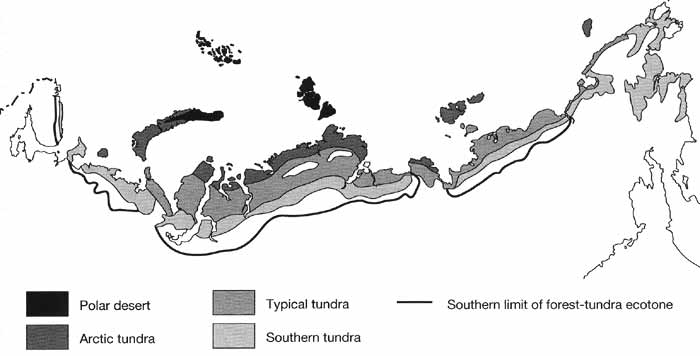Please put an active hyperlink to our site (www.rusnature.info) when you copy the materials from this page
Biomes and Regions of Northern Eurasia
The Arctic Environments
<<< Terrestrial Glaciation | Biomes & Regions Index | Polar Deserts
>>>
Arctic Vegetation: Zonality and Regional Divisions
Within the entire treeless territory around the North Pole, two broad zones are usually
distinguished: the Arctic proper or the high Arctic which includes the Arctic Ocean, the
ice-covered islands and polar deserts (Korotkevich, 1972); and low Arctic or subarctic
which refers to the tundra2 environment (Kryuchkov, 1976). The term 'polar desert' was
first used by Passarge (1920) as a description of the territories extending across the
high latitudes where most of the sea and land is covered by ice, the annual radiation
budget does not exceed 10 kcal cm-2 and the mean temperature of the warmest
month does not exceed 2∞C. Korotkevich (1972) describes the climate of polar deserts as
that 'of perpetual frost, low humidity, and solid precipitation'. The term 'desert' is
used because vegetation in areas not covered by ice is extremely poor and often completely
absent. The vegetation consists mainly of algae, lichens, and mosses with a few specimens
of flowering plants. Unlike in low latitudes, where the formation of deserts is related to
the lack of moisture, the desert appearance in the Arctic is caused by the extreme lack of
heat. The term 'subarctic' was widely introduced by Grigoryev (Grigoryev, 1970) who
originally used it to describe tundra biomes but later included forest-tundra environments
as well. In a wide sense, many authors consider that 'subarctic' means 'south of the
Arctic'.
The distribution of vegetation zones in the Eurasian Arctic is shown in Figure 8.9.

Fig. 8.9 Latitudinal zonality and floristic provinces of the Russian
Arctic
The polar deserts occur on the islands and in the northernmost part of Eurasia (Cape
Chelyuskin). The lowland tundra covers about 4 x 106 km2. It reaches the widest
latitudinal extent of 700 km on the Taymyr peninsula and is limited in European Russia. In
Central and Eastern Siberia, where topography is an important factor, the southern
boundary of the tundra zone is located along the northern slopes of the Central Siberian
plateau and East Siberian mountains. The tundra zone is not uniform; its biomes are shaped
by latitudinal characteristics of climate, degree of continentality, and topography.
Traditionally, in Russian geography and biogeography, three subzones are identified: the
arctic tundra, typical tundra, and southern tundra. Aleksandrova (1980) and Yurtsev (1994)
suggest a different division, identifying the arctic tundra and subarctic tundra subzones,
with a further subdivision of the arctic tundra into the northern and southern belts and
of the subarctic tundra into the northern, middle, and southern belts. In this chapter, we
will use the traditional concept of three subzones. The term 'arctic tundra' is not the
most appropriate one because it is often used in a more general sense to describe the
entire tundra area; however, in the Russian-language literature it is a generally accepted
term. Comparable landscapes in North America are referred to as polar semi-deserts (Bliss
and Matveeva, 1992).
All three tundra subzones as well as polar deserts and the forest-tundra ecotone occur
only on the Taymyr peninsula while in the European north only southern tundras develop.
There are two longitudinal provinces in the polar desert zone: Barents and Siberian
(Aleksandrova, 1988). In the tundra zone three provinces are identified: European Ч West
Siberian Ч Central Siberian, East Siberian, and Chukotka including Wrangel island
(Yurtsev, 1994). The division of the Arctic into longitudinal sectors is mainly based on
the distribution boundaries of vascular plant species. The Chukotka province is closely
linked to Alaska by the presence of many common species. Hulten (1973) and Aleksandrova
(1980) regard both the Chukotka and Alaska areas as a single province, while Yurtsev
refers to the Chukotka and Alaska-Yukon areas as 'twin provinces making up the Beringian
sector of the Arctic' (Yurtsev et al., 1978; Yurtsev, 1994). Having acknowledged the
difference in approaches, we will refer to the area in question as the Chukotka province,
because reviewing the Alaskan flora is beyond the scope of this volume. Regional
characteristics of each sector are a function of topography, continentality of climate,
and vegetation history. The provinces are not homogeneous (i.e., there is a longitudinal
floristic gradient, and a number of subprovinces and districts are identified within each
province) (Yurtsev et al., 1978; Yurtsev, 1994; Aleksandrova, 1980,1988).
<<< Terrestrial Glaciation | Biomes & Regions Index | Polar Deserts
>>>
Contents of the The Arctic Environments
section:
Other sections of Biomes & Regions:
|
|